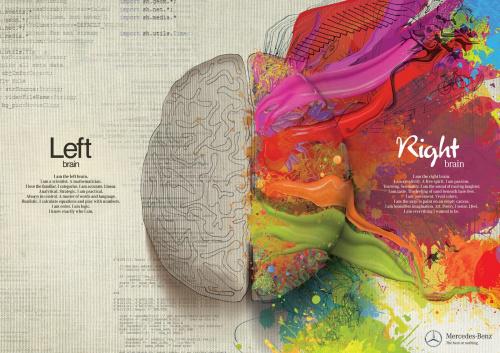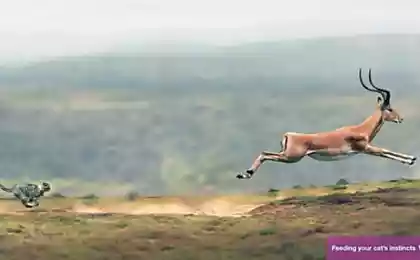660
The myth about the effectiveness of brainstorming
translation of an article published in the magazine The New Yorker. i>
In the late 1940s, Alex Osborn, co-owner of BBDO, the most advanced advertising agency on Madison Avenue, I decided to write a book about the secrets of creativity. He was already one of the most respected people in the advertising industry, so it is the first book of Your Creative Power, is a mixture of business and nauchpop jokes, it became an instant bestseller. Osborne has promised that by following his simple tips, the reader will double their creativity.

Your Creative Power contained a lot of tips on how to enhance creativity, but the key idea was to form a group and to "storm" the problem as it makes special forces - when every soldier working for a private purpose. According to Osborne, its success owes BBDO breynshtormingu and described as an example of how a group of ten advertisers for the new pharmacy has generated 87 ideas in 90 minutes.
The book summarized the basic rules of brainstorming. The most important thing - the lack of negative reaction. Fear of ridicule from other members of the group kills any initiative.

Forget about the quality, strive for quantity. You get a ton of nonsense, but it does not matter. But you will free the imagination and the brain will start to deliver the ideas one by one.
Brainstorming quickly became popular, and Osborne acquired the status of a business guru, and released two more books - Wake Up Your Mind and The Gold Mine Between Your Ears. Breynshtorming proved convenient form of group interaction and the most common technique to find creative solutions. He received recognition both in business and in the scientific community. The main rule - no criticism - is still observed. The design bureau IDEO, once established the first mouse for Apple, brainstorming sessions have become almost a religion.
The methodology of Osborne on the assumption that the fear of being ridiculed makes people keep silent. If the criticism is forbidden, everyone feels as if he has made the common cause significant contribution. Board painted with ideas, everyone is happy - well, just a perfect way to increase productivity. The only problem is that
Brainstorming NOT WORK. For the first time the idea of the strength of the Osborne at Yale University in 1958.
• 48 students were divided into 12 groups, explained the rules and asked to solve a set of brainteasers to enlightenment.
• Another 48 students solve the same problems, but did not receive any instructions.
The result was unexpected. The second group offered twice more ideas and better. Brainstorming not release the creative potential of the group, instead it has reduced the creativity of each member. Subsequent studies confirmed the findings of scientists at Yale University, but the popularity of breynshtorminga it does not hurt. Keith Sawyer, a psychologist at the University of Washington, summed up: "Decades of research show that breynshtormery give less ideas than the same number of people working alone».
In one Osborne was right: work becomes a process group. One of the first he noticed that science ceases to be a lot of singles, "The B. F. Goodrich Research Center (the client BBDO. - Approx.'s) 250 employees, divided into 12 departments, hunt for ideas around the clock».
Ben Jones of Northwestern University examined the US this trend and concluded that over the past half a century, the level of cooperation in science has increased by 95%, and the average size of teams increased by 20% every ten years. Whereas in the past most cited scientific studies were the result of the work of lone geniuses like Darwin and Einstein, today the publication signed by several authors are cited twice as often than articles written alone.
Jones explains this situation complexity of science and the growth of specialization: "A hundred years ago the Wright brothers could build an airplane together. Today, hundreds of engineers of Boeing need only to create the engines. " Thus, an increase in human knowledge and the increasing complexity of new problems, pushing people to the uncomplicated choice - cooperate or torments alone.
But if brainstorming useless, how else should be arranged group work? In 2003, Harlan Nemeth, a professor of psychology at the University of California, conducted an experiment. She gathered 265 students, divide them into groups and set the task.
How to reduce traffic jams in San Francisco?
Group 1 Group 2 Group 3 There is no criticism, just a stream of consciousness.
Feel free to say whatever came to mind. But to argue, too, do not be afraid.
The third group did not receive any advice.
Twenty minutes later, it became clear that the first group (breynshtormery) slightly ahead of the third (zero instructions), but the most productive was the second, the one that is recommended by controversy and criticism. The participants were given 20% more ideas. Later, the students were asked individually whether they have more ideas. The members of the first and the third group came up with an average of three additional solutions, as members of the second (debaters) - seven.
According to Nemeth, breynshtorming ineffective just because of the ban on criticism.

The differences do not prevent the birth of ideas, on the contrary, they encourage them. Disputes can be unpleasant, but they increase productivity.
Another experiment Nemeth showed that contact with other points of view, boosts creativity. The experiment studied the problem of free association. Almost all of the Association are not very good. In the early 1960s, psychologists David Palermo and James Jenkins, interviewing 450 people, found that when a person is called a word and asked to list the association, even the most creative people give shockingly predictable results. At the word "blue" is called "green", "heaven" and "Ocean", the word "green" - "grass". "If you want to hear the original answer, you need to break through the first layer predictable associations", - concluded Nemeth.
Harlan found for this method. The subjects were divided into pairs, we showed them slides of different shades of blue and asked to identify the color. Some couples were "agents" Nemeth who deliberately gave the wrong answer. A little later, people were asked to tell what they associate the color shown. Those who have heard of "agents" wrong answer, come up with more unusual association. In "blue", they responded not banal "heaven," and something like "jazz" and "berry tart." An alternative view, even obviously wrong, wake imagination. Wrong answer is surprising, and surprisingly, in turn catalyze the imagination.

Criticism of the works as well. It kindles the imagination and helps to overcome the barrier of predictability. Brian Uzzi, a sociologist at Northwestern University, has spent years studying the value of conflict in groups and how to build a perfect team. Uzzi grew up in New York, studied music as a child, so as an object for analysis took Broadway.
Brian tried to understand how the relationship between members of the troupe affect the quality of the performance. Who is better - a group of close friends, working together for a long time, or a bunch of people unfamiliar to each other? Uzzi analyzed 474 performances staged in the interval between 1945 and 1989, and found that all the theatrical community permeated with complex relationships. The degree of proximity represented by the letter Q. The stronger were due, the higher the Q, and vice versa.
Uzzi then compared the values of Q with success (fees critics) theater. The correlation proved to be remarkably accurate. At low Q (below 1, on a scale of 7) the most likely outcome was a complete failure. Weak familiar with each other prevented coordinated work and exchange ideas. The high value of Q (above 3, 2) also led to a failure: the troupe worked together so long ago that I could not come up with anything new.
The bad statement A good statement The bad statement Q is less than 1, 7 Q of 1, 4, 3, 2 Q above 3 2 The best result showed the team with the average value Q - 1, 4, 3, 2, and ideally from 2, 4 and 2, 6. Differences occurred, but exactly to the extent that it helps the work, as it did not interfere. One of these teams created the famous musicals "West Side Story».
A few years after Isaac Uzzi Keohane of Harvard Medical School tested, does the proximity of team members on the quality of research work. Quality was measured by Science Citation Index. Eight-month experiment with students showed that the closer to each other working group members, the higher the citation index. The best result showed students working within 10 meters of each other.

If you want an effective team, get a room, which will provide frequent and spontaneous live chat. Even now, when scientists spend so much time on the Internet, all the physical intimacy is just as important.
The scientific and business community to try to use this knowledge. Then all this came Steve Jobs. When designing the new headquarters of Pixar in 1999, he insisted that the central role of the building was assigned to the atrium, which flocked to the staff of all departments of the company. He soon realized that the atrium itself is not enough, we still have to get people to come. Jobs moved into the atrium mailboxes, and then made a reception, café and gift shop. In the end, he thought of place in the atrium of the toilets, the only all huge building, but the decision is met with stiff resistance that Steve had to settle for another block of toilets at the other end headquarters. However, in the main, Jobs was right atrium has become a meeting place and dating. "After the walk for coffee and casual conversation I began to complete more than just sitting at the table," - confessed to Brad Bird, director of The Incredibles and Ratatouille.
And here's another example. Spring of 1942, the Radiation Laboratory at MIT took the new premises. Laboratory developed airborne radar, each month she had to hire hundreds of new employees. Rad Lab offered Building 20, the huge three-storey building area of over 80 thousand sq. M. m. Due to the shortage of time and resources building built something like: roof flowed, it was cold in winter, hot in summer, half-dark corridors, no ventilation. Building 20, had planned to demolish immediately after the war.
In spite of that the building quickly became the center of breakthrough research, an eastern Los Alamos. For several years in the Radiation Laboratory have created a radar for marine navigation, weather forecasting, detection of bombers and submarines.
In 1945, the US Department of Defense announced that the Rad Lab in a short time, the work done, which in peacetime would take 25 years. If the atomic bomb to end the war, it won the radar.
Immediately after the surrender of Japan MIT began to make plans for the demolition of Building 20. Rad Lab evicted, but then there was a mass demobilization, increased number of students, and again there was a lack of space. Twentieth Corps became a haven for electronic research laboratory, which has grown once in Rad Lab, Laboratory of Nuclear Studies, Faculty of Linguistics, a particle accelerator, biological laboratory, ROTC, piano repair shop, store, and student clubs. A lot of people who knew nothing about each other's work, appeared together in a strange building. When the body in 1998 finally demolished, Building 20 had a reputation as one of the most creative places on the planet. After the war, there were a lot of breakthrough research on the physics of high-speed photography to microwaves. In Building 20, was born Bose Corporation, the first video game and Chomsky's linguistics.

Building 20
Paradoxically, creative environment in Block-20 arose because of the shortcomings of the building. The device of the building was such that even the single had to communicate with the rest. Numbering rooms defied any logic (number of premises on the second floor starts at 1, and the third with 2), as well as the names of the wings. Even longtime residents of the building is often lost in the intricacies of the rooms and corridors. To get to the Laboratory of ice, it had to pass through the offices of the military, and the road to the club train simulation ran through the computer lab.
Horizontal flatness of the building also helped establish links. The tall building with many small rooms employees from different departments can meet except in the lobby and an elevator. The low-rise, but a large area home chance encounter in the hallway and strike up a conversation is much higher. Urbanist Jane Jacobs calls such occasional contacts "knowledge spillovers". Her favorite example - the history of the auto industry in Detroit. In 1820 the city had a number of small shipyards. Over time, the shipyards nurtured many specialists in internal combustion engines, and as a result of the beginning of XX century, Detroit was the ideal platform for the automotive industry.
An interesting thing happened in 1950 with the Department of Linguistics, based Morris Hall. Superiors MIT linguistics was a damn, so the faculty have placed in the rundown campus - Building 20. Holly is even pleased. He knocked down walls and created one large room and finally started to practice with the students of the Socratic method. One of the first students was a philologist Holly Carol Chomsky, the linguist Noam Chomsky's wife. Since filing Holly Noam settled at MIT and the next few decades, they worked together in Building 20. In spite of the different specializations (Chomsky - the syntax and grammar, Holly - phonetics), they talked a lot with each other. "We became close friends, and friends should point to each other's mistakes," - said Holly.
After several years at MIT, Chomsky developed the theory of deep structure. The theory was built at the intersection of biology, psychology and computer science. At the time it seemed that between the fields of knowledge have nothing in common - except for the walls twentieth housing MIT.
Building 20 and brainstorms appeared almost simultaneously.
More than half a century later, the result is zero breynshtorminga.
Conclusion: In order to solve a creative problem it is only necessary to choose the right group (sufficient number of people of different specializations from different points of view, partly familiar with each other, there is a part), and then the process will go myself.
Disputes and conflicts can be unpleasant, but they are an integral feature of the creative process. A spark occurs where there is friction between people.
From the interpreter
Translation: Igor Varnavskiy i>
via habrahabr.ru/users/halamyzer/
In the late 1940s, Alex Osborn, co-owner of BBDO, the most advanced advertising agency on Madison Avenue, I decided to write a book about the secrets of creativity. He was already one of the most respected people in the advertising industry, so it is the first book of Your Creative Power, is a mixture of business and nauchpop jokes, it became an instant bestseller. Osborne has promised that by following his simple tips, the reader will double their creativity.

Your Creative Power contained a lot of tips on how to enhance creativity, but the key idea was to form a group and to "storm" the problem as it makes special forces - when every soldier working for a private purpose. According to Osborne, its success owes BBDO breynshtormingu and described as an example of how a group of ten advertisers for the new pharmacy has generated 87 ideas in 90 minutes.
The book summarized the basic rules of brainstorming. The most important thing - the lack of negative reaction. Fear of ridicule from other members of the group kills any initiative.

Forget about the quality, strive for quantity. You get a ton of nonsense, but it does not matter. But you will free the imagination and the brain will start to deliver the ideas one by one.
Brainstorming quickly became popular, and Osborne acquired the status of a business guru, and released two more books - Wake Up Your Mind and The Gold Mine Between Your Ears. Breynshtorming proved convenient form of group interaction and the most common technique to find creative solutions. He received recognition both in business and in the scientific community. The main rule - no criticism - is still observed. The design bureau IDEO, once established the first mouse for Apple, brainstorming sessions have become almost a religion.
The methodology of Osborne on the assumption that the fear of being ridiculed makes people keep silent. If the criticism is forbidden, everyone feels as if he has made the common cause significant contribution. Board painted with ideas, everyone is happy - well, just a perfect way to increase productivity. The only problem is that
Brainstorming NOT WORK. For the first time the idea of the strength of the Osborne at Yale University in 1958.
• 48 students were divided into 12 groups, explained the rules and asked to solve a set of brainteasers to enlightenment.
• Another 48 students solve the same problems, but did not receive any instructions.
The result was unexpected. The second group offered twice more ideas and better. Brainstorming not release the creative potential of the group, instead it has reduced the creativity of each member. Subsequent studies confirmed the findings of scientists at Yale University, but the popularity of breynshtorminga it does not hurt. Keith Sawyer, a psychologist at the University of Washington, summed up: "Decades of research show that breynshtormery give less ideas than the same number of people working alone».
In one Osborne was right: work becomes a process group. One of the first he noticed that science ceases to be a lot of singles, "The B. F. Goodrich Research Center (the client BBDO. - Approx.'s) 250 employees, divided into 12 departments, hunt for ideas around the clock».
Ben Jones of Northwestern University examined the US this trend and concluded that over the past half a century, the level of cooperation in science has increased by 95%, and the average size of teams increased by 20% every ten years. Whereas in the past most cited scientific studies were the result of the work of lone geniuses like Darwin and Einstein, today the publication signed by several authors are cited twice as often than articles written alone.
Jones explains this situation complexity of science and the growth of specialization: "A hundred years ago the Wright brothers could build an airplane together. Today, hundreds of engineers of Boeing need only to create the engines. " Thus, an increase in human knowledge and the increasing complexity of new problems, pushing people to the uncomplicated choice - cooperate or torments alone.
But if brainstorming useless, how else should be arranged group work? In 2003, Harlan Nemeth, a professor of psychology at the University of California, conducted an experiment. She gathered 265 students, divide them into groups and set the task.
How to reduce traffic jams in San Francisco?
Group 1 Group 2 Group 3 There is no criticism, just a stream of consciousness.
Feel free to say whatever came to mind. But to argue, too, do not be afraid.
The third group did not receive any advice.
Twenty minutes later, it became clear that the first group (breynshtormery) slightly ahead of the third (zero instructions), but the most productive was the second, the one that is recommended by controversy and criticism. The participants were given 20% more ideas. Later, the students were asked individually whether they have more ideas. The members of the first and the third group came up with an average of three additional solutions, as members of the second (debaters) - seven.
According to Nemeth, breynshtorming ineffective just because of the ban on criticism.

The differences do not prevent the birth of ideas, on the contrary, they encourage them. Disputes can be unpleasant, but they increase productivity.
Another experiment Nemeth showed that contact with other points of view, boosts creativity. The experiment studied the problem of free association. Almost all of the Association are not very good. In the early 1960s, psychologists David Palermo and James Jenkins, interviewing 450 people, found that when a person is called a word and asked to list the association, even the most creative people give shockingly predictable results. At the word "blue" is called "green", "heaven" and "Ocean", the word "green" - "grass". "If you want to hear the original answer, you need to break through the first layer predictable associations", - concluded Nemeth.
Harlan found for this method. The subjects were divided into pairs, we showed them slides of different shades of blue and asked to identify the color. Some couples were "agents" Nemeth who deliberately gave the wrong answer. A little later, people were asked to tell what they associate the color shown. Those who have heard of "agents" wrong answer, come up with more unusual association. In "blue", they responded not banal "heaven," and something like "jazz" and "berry tart." An alternative view, even obviously wrong, wake imagination. Wrong answer is surprising, and surprisingly, in turn catalyze the imagination.

Criticism of the works as well. It kindles the imagination and helps to overcome the barrier of predictability. Brian Uzzi, a sociologist at Northwestern University, has spent years studying the value of conflict in groups and how to build a perfect team. Uzzi grew up in New York, studied music as a child, so as an object for analysis took Broadway.
Brian tried to understand how the relationship between members of the troupe affect the quality of the performance. Who is better - a group of close friends, working together for a long time, or a bunch of people unfamiliar to each other? Uzzi analyzed 474 performances staged in the interval between 1945 and 1989, and found that all the theatrical community permeated with complex relationships. The degree of proximity represented by the letter Q. The stronger were due, the higher the Q, and vice versa.
Uzzi then compared the values of Q with success (fees critics) theater. The correlation proved to be remarkably accurate. At low Q (below 1, on a scale of 7) the most likely outcome was a complete failure. Weak familiar with each other prevented coordinated work and exchange ideas. The high value of Q (above 3, 2) also led to a failure: the troupe worked together so long ago that I could not come up with anything new.
The bad statement A good statement The bad statement Q is less than 1, 7 Q of 1, 4, 3, 2 Q above 3 2 The best result showed the team with the average value Q - 1, 4, 3, 2, and ideally from 2, 4 and 2, 6. Differences occurred, but exactly to the extent that it helps the work, as it did not interfere. One of these teams created the famous musicals "West Side Story».
A few years after Isaac Uzzi Keohane of Harvard Medical School tested, does the proximity of team members on the quality of research work. Quality was measured by Science Citation Index. Eight-month experiment with students showed that the closer to each other working group members, the higher the citation index. The best result showed students working within 10 meters of each other.

If you want an effective team, get a room, which will provide frequent and spontaneous live chat. Even now, when scientists spend so much time on the Internet, all the physical intimacy is just as important.
The scientific and business community to try to use this knowledge. Then all this came Steve Jobs. When designing the new headquarters of Pixar in 1999, he insisted that the central role of the building was assigned to the atrium, which flocked to the staff of all departments of the company. He soon realized that the atrium itself is not enough, we still have to get people to come. Jobs moved into the atrium mailboxes, and then made a reception, café and gift shop. In the end, he thought of place in the atrium of the toilets, the only all huge building, but the decision is met with stiff resistance that Steve had to settle for another block of toilets at the other end headquarters. However, in the main, Jobs was right atrium has become a meeting place and dating. "After the walk for coffee and casual conversation I began to complete more than just sitting at the table," - confessed to Brad Bird, director of The Incredibles and Ratatouille.
And here's another example. Spring of 1942, the Radiation Laboratory at MIT took the new premises. Laboratory developed airborne radar, each month she had to hire hundreds of new employees. Rad Lab offered Building 20, the huge three-storey building area of over 80 thousand sq. M. m. Due to the shortage of time and resources building built something like: roof flowed, it was cold in winter, hot in summer, half-dark corridors, no ventilation. Building 20, had planned to demolish immediately after the war.
In spite of that the building quickly became the center of breakthrough research, an eastern Los Alamos. For several years in the Radiation Laboratory have created a radar for marine navigation, weather forecasting, detection of bombers and submarines.
In 1945, the US Department of Defense announced that the Rad Lab in a short time, the work done, which in peacetime would take 25 years. If the atomic bomb to end the war, it won the radar.
Immediately after the surrender of Japan MIT began to make plans for the demolition of Building 20. Rad Lab evicted, but then there was a mass demobilization, increased number of students, and again there was a lack of space. Twentieth Corps became a haven for electronic research laboratory, which has grown once in Rad Lab, Laboratory of Nuclear Studies, Faculty of Linguistics, a particle accelerator, biological laboratory, ROTC, piano repair shop, store, and student clubs. A lot of people who knew nothing about each other's work, appeared together in a strange building. When the body in 1998 finally demolished, Building 20 had a reputation as one of the most creative places on the planet. After the war, there were a lot of breakthrough research on the physics of high-speed photography to microwaves. In Building 20, was born Bose Corporation, the first video game and Chomsky's linguistics.

Building 20
Paradoxically, creative environment in Block-20 arose because of the shortcomings of the building. The device of the building was such that even the single had to communicate with the rest. Numbering rooms defied any logic (number of premises on the second floor starts at 1, and the third with 2), as well as the names of the wings. Even longtime residents of the building is often lost in the intricacies of the rooms and corridors. To get to the Laboratory of ice, it had to pass through the offices of the military, and the road to the club train simulation ran through the computer lab.
Horizontal flatness of the building also helped establish links. The tall building with many small rooms employees from different departments can meet except in the lobby and an elevator. The low-rise, but a large area home chance encounter in the hallway and strike up a conversation is much higher. Urbanist Jane Jacobs calls such occasional contacts "knowledge spillovers". Her favorite example - the history of the auto industry in Detroit. In 1820 the city had a number of small shipyards. Over time, the shipyards nurtured many specialists in internal combustion engines, and as a result of the beginning of XX century, Detroit was the ideal platform for the automotive industry.
An interesting thing happened in 1950 with the Department of Linguistics, based Morris Hall. Superiors MIT linguistics was a damn, so the faculty have placed in the rundown campus - Building 20. Holly is even pleased. He knocked down walls and created one large room and finally started to practice with the students of the Socratic method. One of the first students was a philologist Holly Carol Chomsky, the linguist Noam Chomsky's wife. Since filing Holly Noam settled at MIT and the next few decades, they worked together in Building 20. In spite of the different specializations (Chomsky - the syntax and grammar, Holly - phonetics), they talked a lot with each other. "We became close friends, and friends should point to each other's mistakes," - said Holly.
After several years at MIT, Chomsky developed the theory of deep structure. The theory was built at the intersection of biology, psychology and computer science. At the time it seemed that between the fields of knowledge have nothing in common - except for the walls twentieth housing MIT.
Building 20 and brainstorms appeared almost simultaneously.
More than half a century later, the result is zero breynshtorminga.
Conclusion: In order to solve a creative problem it is only necessary to choose the right group (sufficient number of people of different specializations from different points of view, partly familiar with each other, there is a part), and then the process will go myself.
Disputes and conflicts can be unpleasant, but they are an integral feature of the creative process. A spark occurs where there is friction between people.
From the interpreter
Translation: Igor Varnavskiy i>
via habrahabr.ru/users/halamyzer/























